WonJun Moon
Auxiliary Descriptive Knowledge for Few-Shot Adaptation of Vision-Language Model
Dec 19, 2025Abstract:Despite the impressive zero-shot capabilities of Vision-Language Models (VLMs), they often struggle in downstream tasks with distribution shifts from the pre-training data. Few-Shot Adaptation (FSA-VLM) has emerged as a key solution, typically using Parameter-Efficient Fine-Tuning (PEFT) to adapt models with minimal data. However, these PEFT methods are constrained by their reliance on fixed, handcrafted prompts, which are often insufficient to understand the semantics of classes. While some studies have proposed leveraging image-induced prompts to provide additional clues for classification, they introduce prohibitive computational overhead at inference. Therefore, we introduce Auxiliary Descriptive Knowledge (ADK), a novel framework that efficiently enriches text representations without compromising efficiency. ADK first leverages a Large Language Model to generate a rich set of descriptive prompts for each class offline. These pre-computed features are then deployed in two ways: (1) as Compositional Knowledge, an averaged representation that provides rich semantics, especially beneficial when class names are ambiguous or unfamiliar to the VLM; and (2) as Instance-Specific Knowledge, where a lightweight, non-parametric attention mechanism dynamically selects the most relevant descriptions for a given image. This approach provides two additional types of knowledge alongside the handcrafted prompt, thereby facilitating category distinction across various domains. Also, ADK acts as a parameter-free, plug-and-play component that enhances existing PEFT methods. Extensive experiments demonstrate that ADK consistently boosts the performance of multiple PEFT baselines, setting a new state-of-the-art across various scenarios.
Mitigating Semantic Collapse in Partially Relevant Video Retrieval
Oct 31, 2025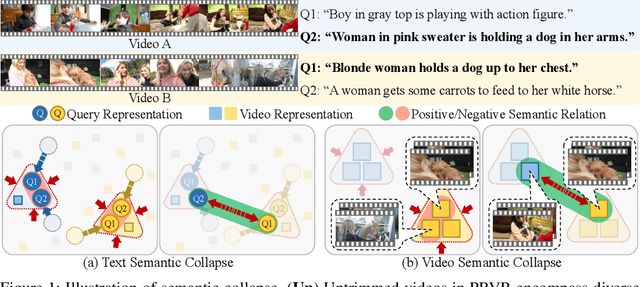
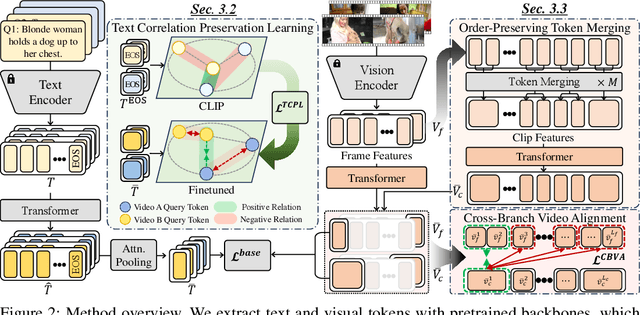


Abstract:Partially Relevant Video Retrieval (PRVR) seeks videos where only part of the content matches a text query. Existing methods treat every annotated text-video pair as a positive and all others as negatives, ignoring the rich semantic variation both within a single video and across different videos. Consequently, embeddings of both queries and their corresponding video-clip segments for distinct events within the same video collapse together, while embeddings of semantically similar queries and segments from different videos are driven apart. This limits retrieval performance when videos contain multiple, diverse events. This paper addresses the aforementioned problems, termed as semantic collapse, in both the text and video embedding spaces. We first introduce Text Correlation Preservation Learning, which preserves the semantic relationships encoded by the foundation model across text queries. To address collapse in video embeddings, we propose Cross-Branch Video Alignment (CBVA), a contrastive alignment method that disentangles hierarchical video representations across temporal scales. Subsequently, we introduce order-preserving token merging and adaptive CBVA to enhance alignment by producing video segments that are internally coherent yet mutually distinctive. Extensive experiments on PRVR benchmarks demonstrate that our framework effectively prevents semantic collapse and substantially improves retrieval accuracy.
Selective Contrastive Learning for Weakly Supervised Affordance Grounding
Aug 11, 2025Abstract:Facilitating an entity's interaction with objects requires accurately identifying parts that afford specific actions. Weakly supervised affordance grounding (WSAG) seeks to imitate human learning from third-person demonstrations, where humans intuitively grasp functional parts without needing pixel-level annotations. To achieve this, grounding is typically learned using a shared classifier across images from different perspectives, along with distillation strategies incorporating part discovery process. However, since affordance-relevant parts are not always easily distinguishable, models primarily rely on classification, often focusing on common class-specific patterns that are unrelated to affordance. To address this limitation, we move beyond isolated part-level learning by introducing selective prototypical and pixel contrastive objectives that adaptively learn affordance-relevant cues at both the part and object levels, depending on the granularity of the available information. Initially, we find the action-associated objects in both egocentric (object-focused) and exocentric (third-person example) images by leveraging CLIP. Then, by cross-referencing the discovered objects of complementary views, we excavate the precise part-level affordance clues in each perspective. By consistently learning to distinguish affordance-relevant regions from affordance-irrelevant background context, our approach effectively shifts activation from irrelevant areas toward meaningful affordance cues. Experimental results demonstrate the effectiveness of our method. Codes are available at github.com/hynnsk/SelectiveCL.
Prototypes are Balanced Units for Efficient and Effective Partially Relevant Video Retrieval
Apr 17, 2025Abstract:In a retrieval system, simultaneously achieving search accuracy and efficiency is inherently challenging. This challenge is particularly pronounced in partially relevant video retrieval (PRVR), where incorporating more diverse context representations at varying temporal scales for each video enhances accuracy but increases computational and memory costs. To address this dichotomy, we propose a prototypical PRVR framework that encodes diverse contexts within a video into a fixed number of prototypes. We then introduce several strategies to enhance text association and video understanding within the prototypes, along with an orthogonal objective to ensure that the prototypes capture a diverse range of content. To keep the prototypes searchable via text queries while accurately encoding video contexts, we implement cross- and uni-modal reconstruction tasks. The cross-modal reconstruction task aligns the prototypes with textual features within a shared space, while the uni-modal reconstruction task preserves all video contexts during encoding. Additionally, we employ a video mixing technique to provide weak guidance to further align prototypes and associated textual representations. Extensive evaluations on TVR, ActivityNet-Captions, and QVHighlights validate the effectiveness of our approach without sacrificing efficiency.
Temporal Alignment-Free Video Matching for Few-shot Action Recognition
Apr 08, 2025



Abstract:Few-Shot Action Recognition (FSAR) aims to train a model with only a few labeled video instances. A key challenge in FSAR is handling divergent narrative trajectories for precise video matching. While the frame- and tuple-level alignment approaches have been promising, their methods heavily rely on pre-defined and length-dependent alignment units (e.g., frames or tuples), which limits flexibility for actions of varying lengths and speeds. In this work, we introduce a novel TEmporal Alignment-free Matching (TEAM) approach, which eliminates the need for temporal units in action representation and brute-force alignment during matching. Specifically, TEAM represents each video with a fixed set of pattern tokens that capture globally discriminative clues within the video instance regardless of action length or speed, ensuring its flexibility. Furthermore, TEAM is inherently efficient, using token-wise comparisons to measure similarity between videos, unlike existing methods that rely on pairwise comparisons for temporal alignment. Additionally, we propose an adaptation process that identifies and removes common information across classes, establishing clear boundaries even between novel categories. Extensive experiments demonstrate the effectiveness of TEAM. Codes are available at github.com/leesb7426/TEAM.
Progressive Proxy Anchor Propagation for Unsupervised Semantic Segmentation
Jul 17, 2024
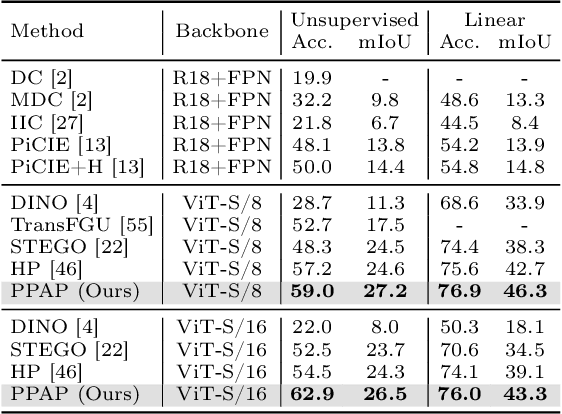
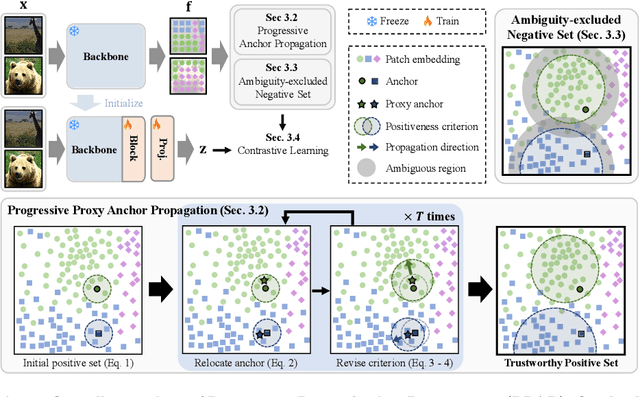
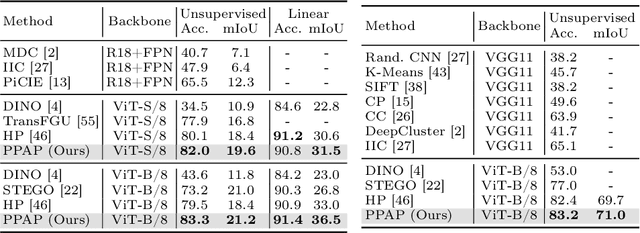
Abstract:The labor-intensive labeling for semantic segmentation has spurred the emergence of Unsupervised Semantic Segmentation. Recent studies utilize patch-wise contrastive learning based on features from image-level self-supervised pretrained models. However, relying solely on similarity-based supervision from image-level pretrained models often leads to unreliable guidance due to insufficient patch-level semantic representations. To address this, we propose a Progressive Proxy Anchor Propagation (PPAP) strategy. This method gradually identifies more trustworthy positives for each anchor by relocating its proxy to regions densely populated with semantically similar samples. Specifically, we initially establish a tight boundary to gather a few reliable positive samples around each anchor. Then, considering the distribution of positive samples, we relocate the proxy anchor towards areas with a higher concentration of positives and adjust the positiveness boundary based on the propagation degree of the proxy anchor. Moreover, to account for ambiguous regions where positive and negative samples may coexist near the positiveness boundary, we introduce an instance-wise ambiguous zone. Samples within these zones are excluded from the negative set, further enhancing the reliability of the negative set. Our state-of-the-art performances on various datasets validate the effectiveness of the proposed method for Unsupervised Semantic Segmentation.
Mitigating Background Shift in Class-Incremental Semantic Segmentation
Jul 16, 2024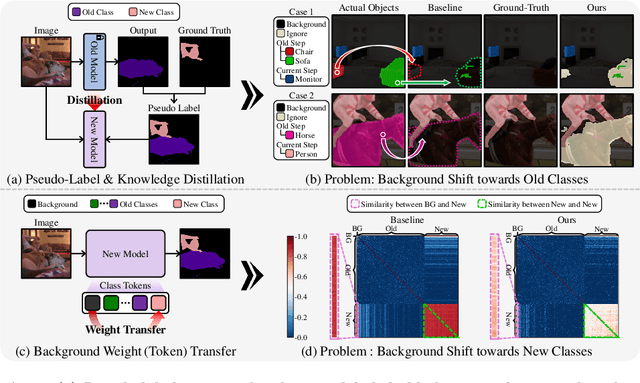
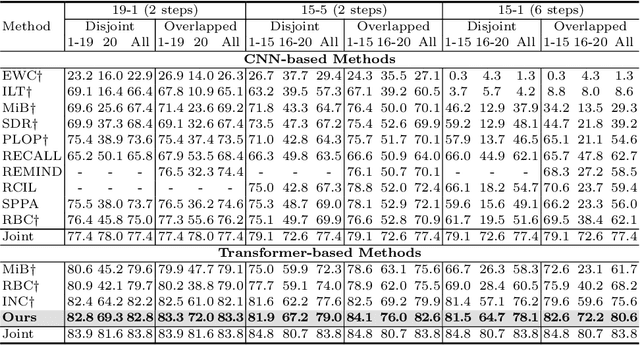
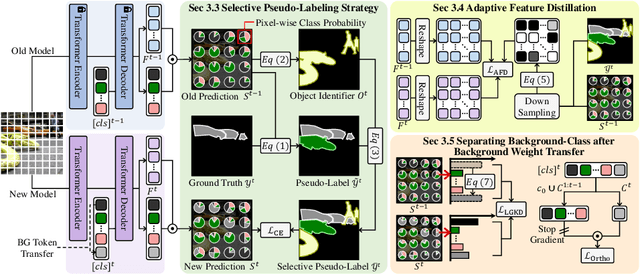
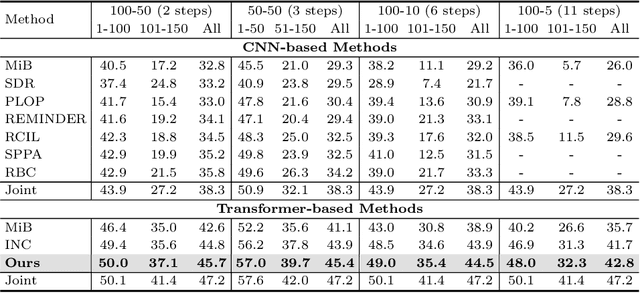
Abstract:Class-Incremental Semantic Segmentation(CISS) aims to learn new classes without forgetting the old ones, using only the labels of the new classes. To achieve this, two popular strategies are employed: 1) pseudo-labeling and knowledge distillation to preserve prior knowledge; and 2) background weight transfer, which leverages the broad coverage of background in learning new classes by transferring background weight to the new class classifier. However, the first strategy heavily relies on the old model in detecting old classes while undetected pixels are regarded as the background, thereby leading to the background shift towards the old classes(i.e., misclassification of old class as background). Additionally, in the case of the second approach, initializing the new class classifier with background knowledge triggers a similar background shift issue, but towards the new classes. To address these issues, we propose a background-class separation framework for CISS. To begin with, selective pseudo-labeling and adaptive feature distillation are to distill only trustworthy past knowledge. On the other hand, we encourage the separation between the background and new classes with a novel orthogonal objective along with label-guided output distillation. Our state-of-the-art results validate the effectiveness of these proposed methods.
VLCounter: Text-aware Visual Representation for Zero-Shot Object Counting
Dec 31, 2023


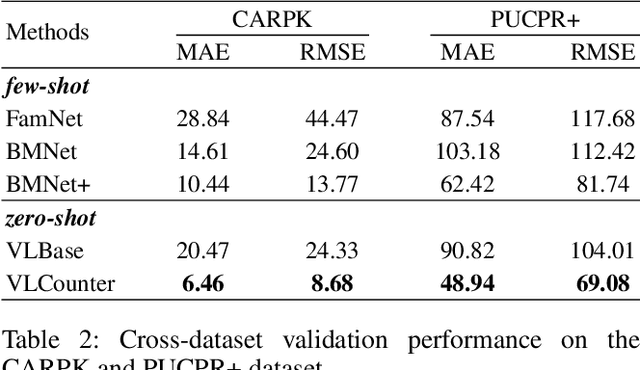
Abstract:Zero-Shot Object Counting (ZSOC) aims to count referred instances of arbitrary classes in a query image without human-annotated exemplars. To deal with ZSOC, preceding studies proposed a two-stage pipeline: discovering exemplars and counting. However, there remains a challenge of vulnerability to error propagation of the sequentially designed two-stage process. In this work, an one-stage baseline, Visual-Language Baseline (VLBase), exploring the implicit association of the semantic-patch embeddings of CLIP is proposed. Subsequently, the extension of VLBase to Visual-language Counter (VLCounter) is achieved by incorporating three modules devised to tailor VLBase for object counting. First, Semantic-conditioned Prompt Tuning (SPT) is introduced within the image encoder to acquire target-highlighted representations. Second, Learnable Affine Transformation (LAT) is employed to translate the semantic-patch similarity map to be appropriate for the counting task. Lastly, the layer-wisely encoded features are transferred to the decoder through Segment-aware Skip Connection (SaSC) to keep the generalization capability for unseen classes. Through extensive experiments on FSC147, CARPK, and PUCPR+, the benefits of the end-to-end framework, VLCounter, are demonstrated.
Correlation-guided Query-Dependency Calibration in Video Representation Learning for Temporal Grounding
Nov 18, 2023



Abstract:Recent endeavors in video temporal grounding enforce strong cross-modal interactions through attention mechanisms to overcome the modality gap between video and text query. However, previous works treat all video clips equally regardless of their semantic relevance with the text query in attention modules. In this paper, our goal is to provide clues for query-associated video clips within the crossmodal encoding process. With our Correlation-Guided Detection Transformer~(CG-DETR), we explore the appropriate clip-wise degree of cross-modal interactions and how to exploit such degrees for prediction. First, we design an adaptive cross-attention layer with dummy tokens. Dummy tokens conditioned by text query take a portion of the attention weights, preventing irrelevant video clips from being represented by the text query. Yet, not all word tokens equally inherit the text query's correlation to video clips. Thus, we further guide the cross-attention map by inferring the fine-grained correlation between video clips and words. We enable this by learning a joint embedding space for high-level concepts, i.e., moment and sentence level, and inferring the clip-word correlation. Lastly, we use a moment-adaptive saliency detector to exploit each video clip's degrees of text engagement. We validate the superiority of CG-DETR with the state-of-the-art results on various benchmarks for both moment retrieval and highlight detection. Codes are available at https://github.com/wjun0830/CGDETR.
Task-Oriented Channel Attention for Fine-Grained Few-Shot Classification
Jul 28, 2023Abstract:The difficulty of the fine-grained image classification mainly comes from a shared overall appearance across classes. Thus, recognizing discriminative details, such as eyes and beaks for birds, is a key in the task. However, this is particularly challenging when training data is limited. To address this, we propose Task Discrepancy Maximization (TDM), a task-oriented channel attention method tailored for fine-grained few-shot classification with two novel modules Support Attention Module (SAM) and Query Attention Module (QAM). SAM highlights channels encoding class-wise discriminative features, while QAM assigns higher weights to object-relevant channels of the query. Based on these submodules, TDM produces task-adaptive features by focusing on channels encoding class-discriminative details and possessed by the query at the same time, for accurate class-sensitive similarity measure between support and query instances. While TDM influences high-level feature maps by task-adaptive calibration of channel-wise importance, we further introduce Instance Attention Module (IAM) operating in intermediate layers of feature extractors to instance-wisely highlight object-relevant channels, by extending QAM. The merits of TDM and IAM and their complementary benefits are experimentally validated in fine-grained few-shot classification tasks. Moreover, IAM is also shown to be effective in coarse-grained and cross-domain few-shot classifications.
 Add to Chrome
Add to Chrome Add to Firefox
Add to Firefox Add to Edge
Add to Edge